Effect of Some Transition Complexes on Bacteria and Fungi Causes Gastroenteritis in Human
Nawal M. J. Al-Shammaa and Hanan A. S. Al-Nuaimi
Department of chemistry, College of pure Sciences Education Ibn-Al-Haitham, Baghdad university.
Corresponding Author E-mail: hnan71437@gmail.com
DOI : http://dx.doi.org/10.13005/ojc/330556
This study concerned with the synthesis and characterization of some complexes of the ligand All the complexes were non-electrolytes complexes crystalline solid compounds insoluble in water , but soluble in some organic solvents the negatively charge bidentate ligand coordinated with metal ions through the oxygen atom in the hydroxyl group and the oxygen atom of the aldehyde group. The effect of these complexes on inhibiting the growth of bacteria and fungi isolated from diarrheal patients with intestinal inflammation has been shown to be highly inhibitory and has been the best inhibitory effect of the complex Zn(OC10 H6 CHO)2 on bacteria Shigella dysentariea inhibition diameter 32 milmeter and on fungus candida glabrata in hibition diameter 27 milimeter and there were no toxic effects of these complex on the Laboratory mice are the dose of 2.5 – 15 gm / kg of body weight.
Transition; Complexes; Bacteria; Fungi; Gastroenteritis
Download this article as:| Copy the following to cite this article: Al-Shammaa N. M. J, Al-Nuaimi H. A. S. Effect of Some Transition Complexes on Bacteria and Fungi Causes Gastroenteritis in Human. Orient J Chem 2017;33(5). |
| Copy the following to cite this URL: Al-Shammaa N. M. J, Al-Nuaimi H. A. S. Effect of Some Transition Complexes on Bacteria and Fungi Causes Gastroenteritis in Human. Orient J Chem 2017;33(5). Available from: http://www.orientjchem.org/?p=36485 |
Gastroenteritis (GIT)
Is a condition called satisfactory inflammation of GLT, which includes both of the stomach and small intestine, which lead to the total of symptoms such as diarrhea, vomiting, abdominal pain and spasm called gastro esophageal(1), is causing the most common cases gastroenteritis in children Rota virus and adults Nor virus(2,3). also may occur because many of bacteria Escherichia coli, Staphylococcus aureus, Salmonella spp, Bacillus spp., Vibrio Cholera and other types of bacteria it may happen due to the consumption of foods stomach improperly or because of drinking contaminated water(4). gastrointestinal tract is more common among infants and children. They cause of death under 5 years age in the developing world(5). And intestinal bacteria transmitted by eating contaminated food especially beef and their products are healthy cows main treasure and high rate was observed in rural as a result of direct contact with cow or the faces containing the bacteria(6).
Properties of Ligand
Ligand 2-hydroxy-1-na phthaldehyde (C11 H8 O2) it is one of the aromatic compound derivatives of naphthalene dark brown crystalline and the degree of melting 76-80oC and boiling point 192oC /27 mm Hg (lit) not soluble in water but soluble in organic solvents molecular weigh 172.183g/mole.
Ligand Preparation
Ligand was prepared by the Gattermann-Kock reaction(also known as the Gattermann salicylaldehyde synthesis) is a chemical reaction in which aromatic compounds are formylated by hydrogen cyanide in the presence of a friedel-crafts catalyst (e.g AlCl3).It is named for the German chemist ludwing Gattermann and is similar to the Friedel-craft reaction. The reaction can be simplified by replacing the HCN/AlCL3 combination with Zinc Cyanide. Although it is also highly toxic.Zn(CN)2 is asoild, making it safer to work with than gaseous HCN,additionally,because the reaction uses HCL,Zn(CN)2also supplies the reaction with ZnCL2in situ, where it acts as a lewis acid catalyst.
Examples of Zn(CN)2being used in this way include the synthesis of 2- hydroxy -1-naphthaldehyde and Mesitaldehyde preparation of ligand .The Ligand (L) was prepared as follows(7):
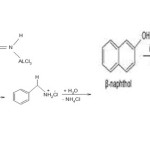 |
Scheme 1 |
Ligand be charged negatively ( L– ) after the loss of a proton ( H+ ) from a hydroxyl group ( OH ) bidentate ligand coordinated with motel ion through the oxygen atom in the hydroxyl group ( – OH ) and the oxygen atom of the carbonyl group shown in figure(1).
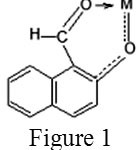 |
Figure 1 |
Material and Methods
Collection of Samples
Sixty four clinical specimens collected for children and adult , distributed between 20 stool sample adults of both sexes and 44 sample of stool of children less on 10 years of age suffer from diarrhea for the duration of January 2016 until august 2016 from different hospitals in Baghdad , collect stool by wooden sticks and placed in a sterile tube containing 2 ml of saline solution then cultured on selective isolation specific media such as macconkey media , blood agar media and initially diagnosed by examination of morphometric traits developing colonies then microscopic examination by using gram stain( 8,9 ) . Then differential Biochemical test like Idols test , methyl red , vogas proskauer, citrate utilization , urea hydrolysis , triple sugar iron test and diagnosis by growth on cultural media like Eosin methyl in blue media , Salmonella – Shigella agar, mannitol salt agar then to confirm used EPI 20 E and API 20 staph( 10 ) . and diagnosed the fungi by culturing on the sabouraud dextrose agar , CHROM agar( 11 ) .
Preparation of Complexes
The chemical was used ligand 2-hydroxy -1-naphthaladehyde and equipped company( E.Merck) and metal salts equipped from different companies fluka,Merck,Ridel-de-Haenage and Al-don Chemical Inc.
Complexes were prepared by taking 0.25 gm ( 1 mmol ) from ligand according molar ratios mentioned earlier and has melting this quantity at the lowest possible amount of ethanol (10 -15) ML then add salt solution of the dissolved in ethanol between (0.33-1) mmol,(0.1-0.24)gm move mix continuous manner where it observed the emergence of a deposit has been nominated and washed with distilled water and ethanol and then returned crystallized with ethanol and dry temperature 50 that some of the complexes needed preparation to a temperature higher than 60 and on the water bath they both complexes [Mn(OC10H6CHO)2],[Ni(OC10 H6 CHO)2] and attended all the complexes in the Neutral surroundings complexes of 2-hydroxy-1-naphaladehyde with some metal salt ( 12 ) .
Study the Effect of Trans Elements Compounds on Growth of Bacteria
Diffusion method used in the agar the note the effect of chemical compounds on the growth of bacteria isolated. Cultured Muller Hinton agar in with sterile swab . loaded bacteria containing 1.5 × 108 cell / milliliter, worked wells on the media ager by cork borer and put the prepared concentrations of each compound by 50 micrometer by each well with a DMSO (Dimethyl sulfoxide). control to confirm that the inhibitory has no effect on the growth of bacteria and leave the microletter in the laboratory temperature for 15 minute then incubated a temperature 37°C in 24 hours and an average of three replicates for each isolated and Identified the complexes effectiveness by measuring the diameter area around each hole and the conference has been three replicate(13) .
Study the Effect of Trans Element on the Growth of Fungi
Fungi prepared from suspension fungal and cultured on the sabouraud dextrose agar and worked in with holes by cork borer and put trans elements compounds in the well and petridishes were let 15 minutes at laboratory temperature and then incubated 24 hr at 37°C with three replicates of each concentration of the transelement and read results by measuring inhibition zone of bacteria around the wells(14) .
Minimum Inhibitory Concentration (MIC) and Minimum Bacteriocidal Concentration (MBC) of Trans Element Complex
The method of turbidity was used( 15 ). In addition to the control tube, add 0.8 ml of sterile brain heart infusion broth (media of bacteria) and other sterile sabouraud dextrose broth (Media of fungi), to the small test tubes. Then add 0.1 ml of the concentration of the selective elements except the control tube and then add 0.1 ml of the bacterial suspension compare with Mac far land tube number 0.5 . the tubes were incubated at 37°C for 18-24 hr . the result were coloured on the basis of the turbidity observation and 100 Microliters were taken from the bacterial mixture or fungal mixture and incubated for a period of 24 hr and temperature 37°C and recorded the result on the basis of the presence of growth number of colonies or Lack of growth.
Lethal Dose of Moderation of Transelement Complexes on the Laboratory Mice by Mouth Dosage
Used 35 of the types of Webster albino Swiss mice for each trans element compound and dosage gradual dose (2.5,5,7.5,10,12.5,15) gram /kg of body weight with total control and repeated the experience the same number of other mice were observed during 96 hours(16).
Result and discussion
It was obtained on 87 isolated from 64 patients diagnosed with inflammation of stomach and intestines of Iraq’s hospitals and diagnosed seven types of bacteria and four species of fungi depending on microscopic, phenotypic, biochemical test and API staph, API 20 E as it is shown in the following table (1).
Table 1: Bacterial and fungi isolation from gastroenteritis
|
Bacteria sp.and fungi |
Total number |
Percentage % |
|
Escherichia co |
23 |
26.40% |
|
Acinetobacter sp . |
5 |
5.70% |
|
Shigella dysentariea |
8 |
% 9 .1 |
|
Staph aureus |
10 |
% 11. 4 |
|
Bacillus subtilus |
9 |
% 10 . 3 |
|
Enterobacter clocae |
12 |
% 13. 6 |
|
Morganella Morganii |
9 |
% 10 . 3 |
|
Candida albicans |
6 |
% 6 .8 |
|
Candida tropicalis |
2 |
2.20% |
|
Candida glabrata |
2 |
2.20% |
|
Candida para psilosis |
1 |
1% |
All the complexes were prepared of interaction the ligand 2-hydroxy-1-naphaladehyde with metal ions cd+2, Zn+2, Vo+2, Cr+3, Ni+2, Mn+2 the reactions required the following molar ratios were used Ligand – metal 1 : 1) with M+1 ions, (1:2) with M+2 ions, 1:3 with M+3 ions All the complexes they are non electrolytes, the general formula has been given for the complexes [M+n (OC10 H6 CHO) m)] where M= metal ions n+ = + 1, + 2, + 3, + 4. m = 1- 4 the negatively charge bidentate Ligand coordinated with metal ions through the oxygen atom in the hydroxyl group(-OH) and the oxygen atom of the carbonyl group.
Table 2: Diameter rate of inhibition of the growth of bacteria isolated from cases of diarrhea impact transelement complex.
|
Bacteria |
[Cd(OC10H6CHO)2] |
[Zn(OC10H6CHO)2] |
[Vo(OC10H6CHO)2] |
[Cr(OC10H6CHO)3] |
Control DMSO |
||||||||||||||||
|
10% |
30% |
50% |
70% |
90% |
10% |
30% |
50% |
70% |
90% |
10% |
30% |
50% |
70% |
90% |
10% |
30% |
50% |
70% |
90% |
||
|
E.coli |
18 |
19 |
21 |
23 |
24 |
15 |
16 |
17 |
18 |
19 |
– |
– |
– |
– |
– |
– |
– |
– |
– |
– |
– |
|
Acinetobacter sp |
19 |
19 |
20 |
21 |
22 |
21 |
22 |
23 |
24 |
24 |
15 |
15 |
16 |
17 |
18 |
– |
– |
– |
– |
– |
– |
|
Shigella dysentariae |
24 |
25 |
26 |
27 |
28 |
27 |
28 |
30 |
31 |
32 |
19 |
20 |
21 |
22 |
23 |
– |
– |
– |
– |
– |
– |
|
Enterobacter clocae |
24 |
25 |
26 |
27 |
28 |
21 |
22 |
23 |
24 |
25 |
31 |
14 |
15 |
16 |
17 |
– |
– |
– |
– |
– |
– |
|
Morganella Morganii |
23 |
24 |
25 |
26 |
27 |
21 |
22 |
23 |
24 |
25 |
12 |
13 |
14 |
15 |
16 |
– |
– |
– |
– |
– |
– |
|
Staph aureus |
20 |
21 |
22 |
24 |
25 |
17 |
18 |
19 |
20 |
21 |
– |
– |
– |
– |
– |
– |
– |
– |
– |
– |
– |
|
Bacillus subtilus |
19 |
19 |
20 |
21 |
23 |
21 |
21 |
22 |
23 |
24 |
12 |
13 |
14 |
15 |
15 |
– |
– |
– |
– |
– |
– |
Table 3
|
[Mn (OC10H6CHO)2] |
[Ni(OC10H6CHO)2] |
Control DMSO |
|||||||||
|
Bacteria |
10% |
30% |
50% |
70% |
90% |
10% |
30% |
50% |
70% |
90% |
– |
|
E.coli |
12 |
13 |
16 |
17 |
18 |
– |
– |
12 |
13 |
13 |
– |
|
Acinetobacter sp |
17 |
17 |
18 |
19 |
20 |
– |
– |
13 |
14 |
15 |
– |
|
Shigella dysentariae |
24 |
25 |
26 |
27 |
28 |
25 |
26 |
27 |
28 |
29 |
– |
|
Enterobacter clocae |
20 |
21 |
22 |
22 |
23 |
17 |
18 |
19 |
20 |
21 |
– |
|
Morganella Morganii |
14 |
15 |
16 |
17 |
18 |
– |
– |
– |
– |
– |
– |
|
Staph aureus |
16 |
17 |
18 |
19 |
20 |
16 |
17 |
18 |
19 |
20 |
– |
|
Bacillus subtilus |
21 |
22 |
22 |
23 |
23 |
– |
12 |
15 |
15 |
16 |
– |
The impact of these trans elements complex may return the effect on bacteria according to their ability to solubility in membranes Lipid so the work inhibitory either be outside the cell or the cell surface or intra cellular cell . the effect of the trans element of bacterial cells in term of their effect on the cell membrane or impermeability so this transformation from an optional permeability to random permeability and thus allow the passage of toxic Material(17) or out material and essential elements of the cell and some of trans elements affect the enzymes produced by the cell , which prevents bacterial work or interference to the cell through the bacterial cell membrane and prevent metabolic reactions in the cell , such as respiratory reactions and thus play elements to the inhibition of bacterial cell growth(18) figures 2,3,4,5.
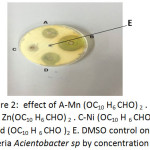 |
Figure 2: effect of A-Mn (OC10 H6 CHO)2. B – Zn(OC10 H6 CHO)2. C-Ni (OC10 H 6 CHO)2 . D -Cd (OC10 H 6 CHO)2 E. DMSO control on bacteria Acientobacter sp by concentration 90%. |
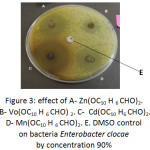 |
Figure 3: effect of A- Zn (OC10 H 6 CHO) 2 . B-Vo (OC10 H6 CHO)2. C-Cd (OC10 H6 CHO) 2 .D- Mn (OC10 H6 CHO)2. E. DMSO control on bacteria Enterobacter clocae by concentration 90% |
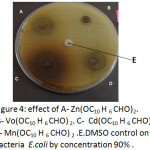 |
Figure 4: effect of A- Zn(OC10 H6 CHO)2. B- Vo(OC10 H6 CHO)2. C- Cd(OC10 H6 CHO)2.D- Mn(OC10 H6 CHO)2. E. DMSO control on bacteria E.coli by concentration 90% .
|
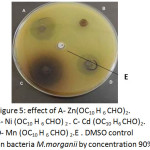 |
Figure 5: effect of A- Zn(OC10 H6 CHO)2 . B-Ni (OC10 H6 CHO)2. C-Cd (OC10 H6 CHO)2. D-Mn (OC10 H6 CHO)2.E. DMSO control on bacteria M.morganii by concentration 90%.
|
The trans elements complexes are highly effective on fungi belonging to the types of candida as in the table (3) and figures 6,7 this could go back to the inhibitory potency of these fungi to effect mitochondria or endoplasmic and plasma membrane and these to inhibit fungus(19)
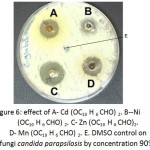 |
Figure 6: effect of A-Cd (OC10 H6 CHO)2. B–Ni (OC10 H6 CHO)2. C- Zn (OC10 H6 CHO) 2.D- Mn (OC10 H6 CHO)2. E. DMSO control on fungi candida parapsilosis by concentration 90%. |
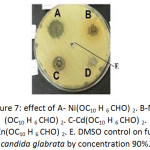 |
Figure 7: effect of A-Ni(OC10 H6 CHO) 2. B-Mn (OC10 H6 CHO)2. C-Cd(OC10 H6 CHO) 2.D- Zn(OC10 H 6 CHO) 2. E. DMSO control on fungi candida glabrata by concentration 90%.
|
The Trans Elements Complex were
Effective in inhibiting and killing different bacterial and fungal isolates . The best inhibitory agent was [ Cd (OC10H6CHO )2 ] on bacteria Enterobacter cloacae , Sh . dysenteries and candida sp. with concentration 5% it is best to kill the same bacteria and fungus with concentration 10% as shown the table (4).
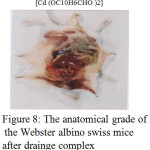 |
Figure 8: the anatomical grade of the Webster albino swiss mice after drainge complex |
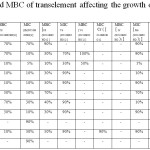 |
Table 4: MIC and MBC of transelement affecting the growth of bacterial and fungal isolates |
and there is no effective toxicity or loss on laboratory mice exposed to different concentrations of trans element and there are no histological or hemorrhagic effects on laboratory mice at dissection after 96 hours at different concentrations as shown figure 8.
Reference
- Singh, A. (2010) pediatric emergency medicine practice Acute gastro–enteritis An update emergency Medicine practice 7.
- Tate J. E ., Burton A. tl, Bosch – pinto, C, Steele AD , Duque J., preacher UD . (2012), (2008) estimate of world wide Rota virus associated mortality in children younger than 5 years before the introduction of universal Rota virus vaccination programmers a systematic review and meta analysis the lancet in factious disease 12 (2) : 136 – 41 .
- Marshall J. A, Bruggink LD. (2011) the dynamics of nor virus outbreak epidemics recent insights . international Journal of Environmental research and public health 8 : (4) : 11419
- Manism (2011). the clinical importance of emerging campylobacter species nature review gastroenterology and hematology 8 (12): 669 -85
- king CK, Glass R., Breese J. S, Duggan C. (2003) Managing acute gastroenteritis among children: oral rehydration maintenance and nutritional the ropy MMWR . Recomm Rep. 52 (P R – 16) – 1 – 16 .
- WHO (1982) Diarrheal disease control program , Report of the second meeting of scientific working group on viral disease microbiology , epidemiology and vaccine wall, 3 : 1 – 23.
- LIJie Jack (2003).Name Reaction.Acollection of Detailed Reaction Mechanisms(available on Google Books) (2nd ed.) Springer. P.157.ISBN 3-540-40203-9.
- facklam , P . R and Teixeira , L . M ( 1997 ) Enterococcus . In collier A . Below , S . and Susana , M. [Eds] microbiology and microbial infections to piney and Wilson , 9 thud . Edward Arnold London , p p . 669 – 682.
- A waysid , H . S , Kamas , K h , M ( 2013 ) Effect of entrain produced by Enterococcus fecal is on bacteria that cause diarrhea in children and young sheep Journal of AL–Qadessic science of veterinary medicine (12) (1) . 2013.
- Johnson , R.MCD on ads , L – and Gray S. 1997 , Improved detection and isolation of Vero toxigenic E–coli in mixed cultures P . P 108 in 3 rd international symposium and work shop on shiga Toxin ( Vero toxin )– producing E . coli infections . Lois Joy Gallery foundation for hemolytic uremic syndrome Inc . Melville , N . Y .
- Thomas,j.liesegang,M,D.,Richard ,K.Foster M,D.(1980) Spectrum of microbial keratitis in south florida .j.American of ophthalmology ,90 ISSUE 7 .38-47
- Rahim . T . Mehdi and A.M. Ali , National Journal of chemistry 2005 , 540 . 516.
- Vandepite , J. N ngback , k ; piot p . and Heuk C. (1991) .Basic Laboratory procedures in clinical bacteriology world health organization Geneva .
- Prescott,L.M.Harley,J.P.and Klien,D.A.(1993).microbiology,2nd.ed .W.M.Brown .puplishers,London,Chicago.
- Atlas , R . M . Brown , A . E and parks , L .C. (1995) . Experimental microbiology Laboratory manual . MC. Grow . Hill companies Mos – by company . st . Louis .
- Klessen , C.D , lethal dose Amdar , M . O , Doull , J (1986 ) casarett and Doulls Toxicology the basic science of poisons 3 reed . MacDill on publishing company , Network .
- Abdul R .R . H (2012) the effect of some disinfectant on the growth of the no cardiac a steroids bacteria isolated from soil J/science of Timidity (3) 17 pp 106 / SSN – 1813 – 160 .
- Keswick , B . H . (1985) in activation of Norwalk virus in drinking water by chlorine Applied and environmental Microbiology.
- Poreira, M . C . Chalfont , M .C. Pimento C.H.(2006) species fungi Mycelia development and achratoxin production scientific research and assay 2 p 38 – 42

This work is licensed under a Creative Commons Attribution 4.0 International License.









